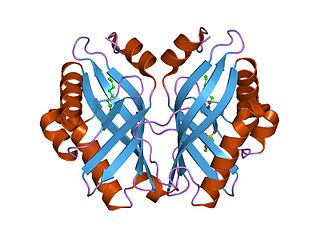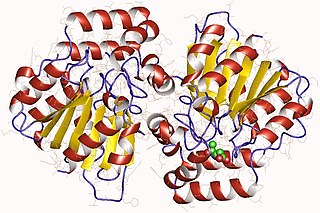| carboxymethylenebutenolidase | |||||||||
|---|---|---|---|---|---|---|---|---|---|
| Identifiers | |||||||||
| EC no. | 3.1.1.45 | ||||||||
| CAS no. | 76689-22-0 | ||||||||
| Databases | |||||||||
| IntEnz | IntEnz view | ||||||||
| BRENDA | BRENDA entry | ||||||||
| ExPASy | NiceZyme view | ||||||||
| KEGG | KEGG entry | ||||||||
| MetaCyc | metabolic pathway | ||||||||
| PRIAM | profile | ||||||||
| PDB structures | RCSB PDB PDBe PDBsum | ||||||||
| Gene Ontology | AmiGO / QuickGO | ||||||||
| |||||||||
In enzymology, a carboxymethylenebutenolidase (EC 3.1.1.45, also known as CMBL and dienelactone hydrolase) is an enzyme that catalyzes the chemical reaction
- 4-carboxymethylenebut-2-en-4-olide + H2O 4-oxohex-2-enedioate
Thus, the two substrates of this enzyme are 4-carboxymethylenebut-2-en-4-olide and H2O, whereas its product is 4-oxohex-2-enedioate.
This enzyme belongs to the family of hydrolases, specifically those acting on carboxylic ester bonds. The systematic name of this enzyme class is 4-carboxymethylenebut-2-en-4-olide lactonohydrolase. Other names in common use include maleylacetate enol-lactonase, dienelactone hydrolase, and carboxymethylene butenolide hydrolase. This enzyme participates in gamma-hexachlorocyclohexane degradation and 1,4-dichlorobenzene degradation.





